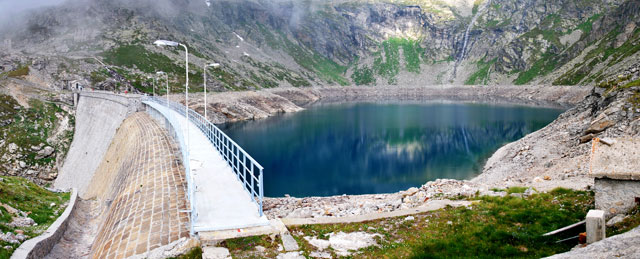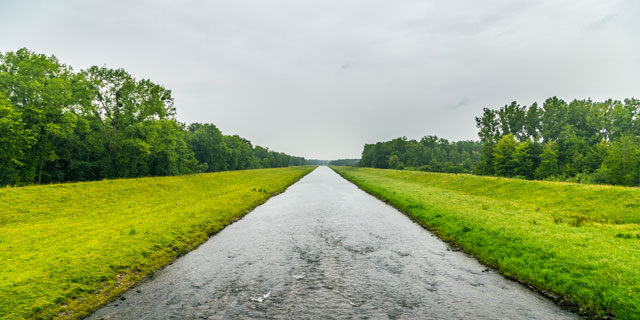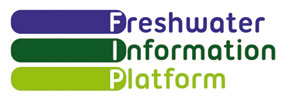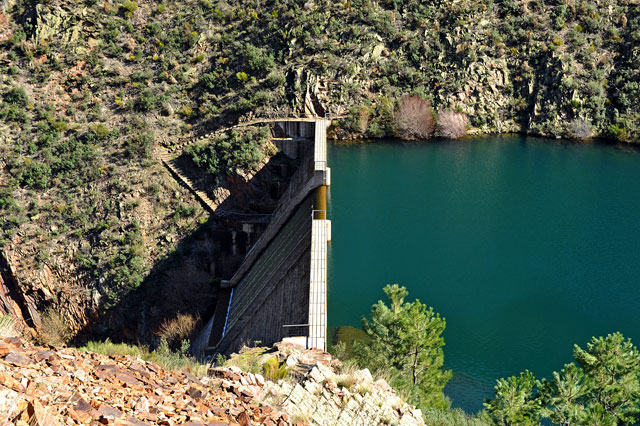Hydrological alteration
Rivers and streams have seasonally variable patterns in their flows of water, sediment and nutrients, often termed a ‘hydrological regime’. Human activities such as energy production, flood protection, agriculture and inland water transport can all directly affect hydrological regimes, whilst anthropogenic carbon emissions which drive ongoing climatic change are likely to have indirect, but potentially widespread and unpredictable, impacts on river hydrology across Europe in decades to come. Hydrological alterations can cause a range of pressures on aquatic ecosystem health and service provision, including: changes to the quantity, quality, velocity and temperature of water flows, changes to channel and bed erosion and deposition processes, intermittent or temporary river flows, flash floods, and alterations in water availability to riparian and floodplain environments adjacent to water bodies.

Reservoir of the hydroelectric complex in the Valle Antrona, Italy

Straight canal in Elsass

Irrigation reservoir near Madrid with low water level due to a drought period, Spain

Sluice complex in Twente channel at Eefde, the Netherlands
Pressure types
There are a number of hydrological pressures generated by different drivers:
Energy
Hydropower - hydropower projects generate electricity in response to demand, which means that the water flows they subsequently release can be highly variable. Such pulses of water can significantly alter the quantity, speed and temperature of water flows downstream in a short period of time: a phenomenon known as ‘hydropeaking’. Hydropeaks can rapidly alter river hydrology; placing pressure on invertebrate, plant and fish populations (which may be forced to ‘drift’ or be stranded by receding water levels) and potentially causing periodic channel erosion in downstream ecosystems. Hydropower projects also alter the hydrology upstream of their construction through the creation of reservoirs (REFORM 2015a).
Flood protection
Channelisation, dams, embankments – channelizing and embanking streams and rivers increases discharge capacity, shortens water travel times and exacerbates both high and low flows. Dams protect coastlines and transitional waters from storm surges, but can modify tidal regimes in estuaries and deltas, and migration routes for fish species.
Agriculture
Irrigation reservoirs - agricultural practices in water-scarce regions of Southern Europe often involve the construction of reservoirs along natural water bodies to provide reliable sources of water for irrigation. Such reservoirs can significantly alter the annual hydrological regime of connected rivers, as water flows are maximised in the summer to provide water for irrigation, but minimised in the winter to allow reservoirs to re-fill. Such variations in downstream flows can impact biodiversity through fluctuating habitat availability, alter channel morphology and sediment erosion, water chemistry and temperature and impair the health of riparian vegetation (REFORM 2015b).
Diversions - river flows may be diverted through artificial channels in order to irrigate crops, which can reduce the quantity and velocity of downstream flows, and potentially lead to intermittent or temporary rivers, which are dry for periods of time each year. Long distance diversions may be implemented to supply water scarce regions by transferring water from one river basin to another.
Aquaculture
Alteration of flow and water level - freshwater aquaculture facilities may draw water flows from nearby rivers and streams in order to supply their nursery tanks.
Transport
Creation of navigable waterways - hydrological flows have been altered in European rivers for decades, as navigable waterways for shipping have been created through the deepening, straightening and channelisation of natural river courses.
Climate Change
Extreme variability - climate change is predicted to bring more extreme weather events to Europe in the coming decades, with flooding and droughts that exceed current hydrological variability. In already water-stressed areas, droughts from climate changes may prompt negative feedback loops by increasing demands on available water resources (EEA 2012).
Geographical distributions and trends
There are currently around 7,000 large dams (larger than 10-15 metres in height) and thousands more smaller dams across Europe, with many located in Scandinavia and the Alps where hydropower generation is high (EEA 2012, EEA 2016). Smaller barriers or ‘transverse’ structures are common across the continent, for example there are around 200,000 transverse structures in Germany on network of watercourses of around 400,000 km (EEA 2012).
Spain has the largest number of reservoirs (many of which are used for irrigation) in Europe, with around 1,200 (EEA 2008). Many of the last remaining ‘un-fragmented’ rivers in Europe are located in the Balkans, however, there are over 1,600 proposed hydropower plants for rivers in the region, around half of which are located in existing protected areas (RiverWatch 2015).
Stressors generated
The key stressors generated by physical alteration pressures are morphological (i.e alterations to the shape, course and shoreline of a water body) and hydrological (i.e. alterations to the quantity, flows and timings of water dynamics in a water body). Dammed reservoirs may facilitate biological (e.g. invasive species) and chemical (e.g. toxic algal blooms) stressors, whilst hydropower and industry drivers may create thermal stressors through the release of water at a different temperature to the water body.
Potential for mitigation
The mitigation of barrier pressures in rivers is a key strategy for ‘re-naturation’ restoration management, both at a small scale (e.g. the removal of small weirs, or installation of fish ladders) and a large scale (e.g. the decommissioning and demolition of large dams, such as the 23 metre high Robledo de Chavela dam on the Cofio River in Spain in 2014). However, as dams amplify a range of valuable ecosystem services such as drinking water supply and hydropower production, there are significant demands for their continued construction and use across Europe (RiverWatch 2015).
Further reading
Reports and publications:
EC (2012). Guidance document on Inland waterway transport and Natura 2000 (Download report, 3.7mb)
EC (2013). A Water Blueprint for Europe (Download report, 1.28mb)
EEA (2012). European waters - assessment of status and pressures (Download report, 28mb)
EEA (2015). The European Environment - State and Outlook 2015 - Urban Environment - Synthesis Report (Download report, 15.8mb)
STAR-FLOOD (2014). Flood Risk Management in Europe – similarities and differences between the STAR-FLOOD consortium countries (Download report, 1.3mb)
Selected Freshwater blogs:
Freshwaterblog (2015). What influences the ecological success of river restoration? (External website)
Freshwaterblog (2017). Restoring Swindale Beck (External website)
Freshwaterblog (2017). How groundwater influences Europe’s surface waters (External website)
Other websites:
European Environmental Agency - Reservoirs and dams (External website)
European Commission - A Water Blueprint – taking stock, moving forward (External website)
REFORM (2015a). Hydropeaking (External website)
REFORM (2015b). Hydrological regime modification (External website)





